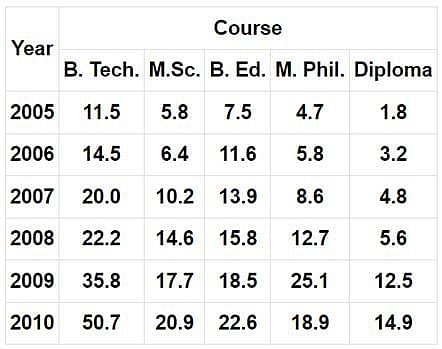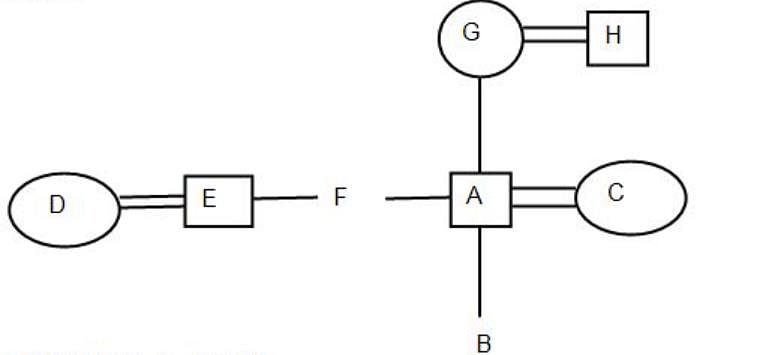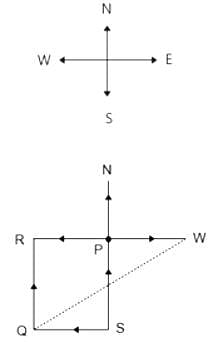SSC Selection Post Mock Test - 5 - SSC Exams MCQ
30 Questions MCQ Test - SSC Selection Post Mock Test - 5
Directions: Study the following information carefully to answer the given Questions:
P^Q - P is the child of Q
P!Q - P is the parent of Q
P*Q - P is elder to Q
P#Q - P is younger to Q
P@Q - P is brother of Q
P&Q - P is wife of Q
P+Q - P is sister-in-law of Q
Q. If A!B^C+D&E@F^G!A and G is the wife of H then how is G related to C?
P!Q - P is the parent of Q
P*Q - P is elder to Q
P#Q - P is younger to Q
P@Q - P is brother of Q
P&Q - P is wife of Q
P+Q - P is sister-in-law of Q
Two matrices are shown in the figure below. Their rows and columns are labelled as (0,1,2,3,4) and (5,6,7,8,9) in the manner shown. Find the correct row-column pairs out of the following matrices that decode to the word - CAGE

| 1 Crore+ students have signed up on EduRev. Have you? Download the App |
Two matrices are shown in the figure below. Their rows and columns are labelled as (0,1,2,3,4) and (5,6,7,8,9) in the manner shown. Find the correct row-column pairs out of the following matrices that decode to the word - FACE

Directions: Read the given information carefully and answer the questions given beside:
Nine persons – Chaya, Dimple, Beena, Ajit, Jaya, Fatima, Gagan, Hemant and Kaushal – are sitting in a straight line facing north, but not necessarily in the same order.
Beena is fourth to the left of Gagan; Fatima is fourth to the right of Chaya and second to the left of Kaushal, who is fifth to the right of Ajit. Dimple is not an immediate neighbour of either Kaushal or Beena. There are only three persons between Jaya and Ajit. Gagan is second to the right of Chaya.
Q. Who among the following sit at the extreme ends of the line?
Directions: Study the following information carefully and answer the questions given below:
Point N is 15 m to the north of P and W is 20m to the east of point P, which is to the north S. R is to the west of P and 15m to the north of Q, which is 18m to the west of S.
Q. Point W is in which direction with respect to point Q?
Raju can do 25% of a piece of work in 5 days. How many days will he take to complete the work ten times?
Nishu and Archana can do a piece of work in 10 days and Nishu alone can do it in 12 days. In how many days can Archana do it alone?
When the price of rice is increased by 30 percent, a family reduces its consumption such that the expenditure is only 20 percent more than before. If 50 kg of rice is consumed by family before, then find the new consumption of family (approx.)
A man has 4000 rupees in his account two years ago. In the first year he deposited 20 percent of the amount in his account. In the next year he deposited 10 percent of the increased amount in the account. Find the total amount in the account of the person after 2 years.
Vijay bought some pens for Rs. 540. He lost 2 pens on his way back to the shop. Then, he sold the rest of the pens at Rs. 6 more (per pen) than what he paid for them. On the whole transaction, Vijay gained 10% on his outlay. How many pens did Vijay buy?
Gopal, a cunning milkman, buys milk from Frontier Dairy Junction and sells it to gullible housewives. He buys milk at Rs. 35 per litre and adds 250 ml of pure water to a litre of the thick creamy milk. He sells the mixture so formed at Rs. 45 per litre. What is his approximate profit percentage? It is to be assumed that it costs him next to nothing to mix the milk in water.
Directions: Study the following table carefully and answer the questions that follow:
Semester fees (In Rs. thousands) for five Different Courses in 6 different years.

Q. What was the total semester fee charged for all the course together in the year 2006?
Find out the Synonym of the following word:
ADVERSITY
Find out the Synonym of the following word:
FAKE
Read the each sentence to find out whether there is any grammatical error in it. The error, if any will be in one part of the sentence. The letter of that part is the answer. If there is no error, the answer is 'D'. (Ignore the errors of punctuation, if any).
Read the each sentence to find out whether there is any grammatical error in it. The error, if any will be in one part of the sentence. The letter of that part is the answer. If there is no error, the answer is 'D'. (Ignore the errors of punctuation, if any).
Directions: Rearrange the following six sentences (1), (2), (3), (4), (5) and (6) in the proper sequence to form a meaningful paragraph and then answer the question given below.
1. Officials of the Russian-American Company reasoned that a permanent settlement along the more temperate shores of California could serve both as a source of food and a base for exploiting the abundant sea otters in the region.
2. The Russians had begun their expansion into the North American continent in 1741 with a massive scientific expedition to Alaska.
3. By the early 19th century, the semi-governmental Russian-American Company was actively competing with British and American fur-trading interests as far south as the shores of Spanish-controlled California.
4. As a growing empire with a long Pacific coastline, Russia was in many ways well positioned to play a leading role in the settlement and development of the West.
5. Returning with news of abundant sea otters, the explorers inspired Russian investment in the Alaskan fur trade and some permanent settlement.
6. Russia's Alaskan colonists found it difficult to produce their own food because of the short growing season of the far north.
Q. Which of following is the FOURTH sentence after rearrangement?
Direction: Each question below has one blank, which is indicating that something has been omitted. Find out which option can be used to fill up the blank in the sentence in the same sequence to make it meaningfully complete.
Buying a home is one of the most _____________ financial decisions we need to take.
The active voice sentence "The dog chased the cat" can be changed to passive voice as:
Directions: Read the passage and answer the questions that follow:
Development is about expanding the capabilities of the disadvantaged, thereby improving their overall quality of life. Based on this understanding, Maharashtra, one of India’s richest States, is a classic case of a lack of development which is seen in its unacceptably high level of malnutrition among children in the tribal belts. While the State’s per capita income has doubled since 2004, its nutritional status has not made commensurate progress.
Poor nutrition security disproportionately affects the poorest segment of the population. According to NFHS 2015-16, every second tribal child suffers from growth restricting malnutrition due to chronic hunger. In 2005, child malnutrition claimed as many as 718 lives in Maharashtra’s Palghar district alone. Even after a decade of double digit economic growth (2004-05 to 2014-15), Palghar’s malnutrition status has barely improved.
In September 2016, the National Human Rights Commission issued notice to the Maharashtra government over reports of 600 children dying due to malnutrition in Palghar. The government responded, promising to properly implement schemes such as Jaccha Baccha and Integrated Child Development Services to check malnutrition. Our independent survey conducted in Vikramgad block of the district last year found that 57%, 21% and 53% of children in this block were stunted, wasted and underweight, respectively; 27% were severely stunted. Our data challenges what Maharashtra’s Women and Child Development Minister said in the Legislative Council in March — that “malnutrition in Palghar had come down in the past few months, owing to various interventions made by the government.”
Stunting is caused by an insufficient intake of macro- and micro-nutrients. It is generally accepted that recovery from growth retardation after two years is only possible if the affected child is put on a diet that is adequate in nutrient requirements. A critical aspect of nutrient adequacy is diet diversity, calculated by different groupings of foods consumed with the reference period ranging from one to 15 days. We calculated a 24-hour dietary diversity score by counting the number of food groups the child received in the last 24 hours. The eight food groups include: cereals, roots and tubers; legumes and nuts; dairy products; flesh foods; eggs; fish; dark green leafy vegetables; and other fruits and vegetables.
In most households it was rice and dal which was cooked most often and eaten thrice a day. These were even served at teatime to the children if they felt hungry. There was no milk, milk product or fruit in their daily diets. Even the adults drank black tea as milk was unaffordable. Only 17% of the children achieved a minimum level of diet diversity — they received four or more of the eight food groups. This low dietary diversity is a proxy indicator for the household’s food security too as the children ate the same food cooked for adult members.
Q. What is ironical about the situation mentioned in paragraph 1?
Directions: Out of the given alternatives, choose the one which can be substituted for the given words/sentence.
A person who is womanish in his habits
During the Indian Freedom Struggle, why did Rowlatt Act arouse popular indignation?
During whose Governor Generalship the Maratha confederacy ended?
What was the bowling figures (O-M-R-W ) of Anil Kumble in his ODI debut against Sri Lanka?
In the history of Indian population, which duration period is referred to as 'A great leap forward'?
Which country will host the first offshore campus of the Indian Institute of Technology (IIT) Madras?
Which city in Madhya Pradesh has become the first urban body in India to receive Extended Producers Responsibility (EPR) credit for effectively recycling banned single-use plastic items?
Which city is hosting the fourth edition of the Space Economy Leaders Meeting?








 On simplifying, we get
On simplifying, we get














